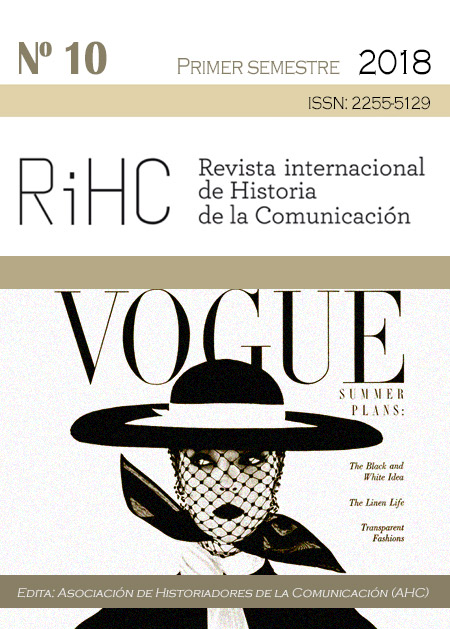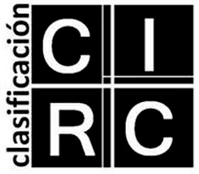Análisis de los primeros estudios sobre el liderazgo personal y la difusión de tendencias de moda (1950-2000)
DOI:
https://doi.org/10.12795/RiHC.2018.i10.06Palabras clave:
Líderes de opinión, moda, difusión de tendencias, LazarsfeldResumen
Los estudios sobre el liderazgo de opinión comenzaron con las aportaciones de Paul Lazarsfeld y sus compañeros de la Escuela de Columbia (Katz & Lazarsfeld, 1955), cuando Lazarsfeld desarrolló su teoría de “the-two-step-flow of communication” que incidía en los efectos limitados de los medios. Además, Lazarsfeld indicó que la moda, por su dinamismo, era un campo propicio para el análisis del papel de la comunicación personal y del liderazgo de opinión. El presente artículo analiza los estudios en este campo entre los años 1950 y 2000; una evolución en la que se establecen las bases sobre las características de los líderes de opinión en moda como medidores de la cultura y valores sociales, fuentes de información, fuentes de consejo, modelos de comportamiento en moda, fuentes de seguridad para la aceptación social. La revisión cronológica de los estudios permite un análisis en profundidad en el que aparecen las claves sobre el papel de la comunicación personal, cuestión relevante en la difusión de las tendencias de moda.
Descargas
Citas
BAUMGARTEN, S.A. (1975): “The innovative communicator in the diffusion process”. Journal of Marketing Research, JSTOR, 12(1), pp. 12–18.
BEAUDOIN, P., MOORE, M.A., AND GOLDSMITH, R.E. (1998): “Young fashion leaders’ and followers’ attitudes toward American and imported apparel”. Journal of Product & Brand Management, MCB UP Ltd, 7(3), p. 193.
BLUMER, H. (1969): “Fashion: From Class Differentiation to Collective Selection”. The Sociological Quarterly. Wiley on behalf of the Midwest Sociological Society, 10(3), pp. 275–291.
BOURDIEU, P. (2002): La distinción: criterio y bases sociales del gusto. México: Taurus.
BRETT, J.E. AND KERNALEGUEN, A. (1975): “Perceptual and personality variables related to opinion leadership in fashion”. Perceptual and motor skills. Perceptual & Motor Skills, 40(3), pp. 775–779.
CURIEL, C. P., AND ORTIZ, S. L. (2018): “El marketing de influencia en moda. Estudio del nuevo modelo de consumo en Instagram de los millennials universitarios”. adComunica, (15), 255-281.
DARDEN, W.R. AND REYNOLDS, F.D. (1972): “Predicting opinion leadership for men’s apparel fashions,” Journal of Marketing Research. JSTOR, 9(3), pp. 324–328.
DAVIS, L.L. AND LENNON, S.J. (1985): “Self-monitoring, fashion opinion leadership, and attitudes toward clothing,” Psychology of Fashion. Health. Lexington, MA, pp. 177–182.
GOLDSMITH, R.E. AND STITH, T. (1993): “The Social Value of Fashion Innovators”. Journal of Applied Bussiness Research, (9)1, pp. 10–16.
GOLDSMITH, R.E., FREIDEN, J.B. AND KILSHEIMER, J.C. (1993): “Social values and female fashion leadership: A cross‐cultural study”. Psychology & Marketing. Wiley Online Library, 10(5), pp. 399–412.
GOLDSMITH, R.E., HEITMEYER, J. R. AND FREIDEN, J.B. (1991): “Social values and fashion leadership”. Clothing and Textiles Research Journal. Sage Publications, 10(1), pp. 37–45.
GRINDERENG, M.P. (1967): “Fashion diffusion”. Journal of Home Economics, 59(3), pp. 171–174.
JANNEY, J.E. (1941): “Fad and fashion leadership among undergraduate women”. The Journal of Abnormal and Social Psychology. American Psychological Association, 36(2), p. 275.
KATZ, E. AND LAZARSFELD, P.F. (1955): Personal Influence. The part played by people in the flow of mass communications. Transaction Publishers. ― (2011) Personal Influence. The part played by people in the flow of mass communications. Transaction Publishers.
KING, C.W. (1965): “Fashion adoption: A rebuttal to the’trickle down’theory”, en MCNEAL, James Dimensions of consumer behavior. Chicago: American Marketing Association, 1965, pp. 108–125.
KING, C.W. AND SUMMERS, J.O. (1970): “Overlap of opinion leadership across consumer product categories”. Journal of Marketing Research. JSTOR, 7(1), pp. 43–50.
KING, C.W., TIGERT, D. J. AND RING, L. J. (1975): “Contemporary Fashion Theory and Retail Shopping Behavior: A Segmentation Analysis”. in Marketing Educators’ Conference of the American Marketing Association, Rochester, New York.
LAZARSFELD, P.F., BERELSON, B. AND GAUDET, H. (1944): The people’s choice: how the voter makes up his mind in a presidential campaign. New York: Columbia University Press, 1968;
LIPOVESTKY, G. (1990): El imperio de lo efímero. La moda y su destino en las sociedades modernas. Barcelona: Anagrama.
MEYERSOHN, R. AND KATZ, E. (1957): “Notes on a natural history of fads”. American Journal of Sociology. JSTOR, 62(6), pp. 594–601. doi: 10.1086/222108.
MATTHEWS, R. (2015): Contemporary Fashion Tastemakers: Starting Conversations that Matter. Catwalk: The Journal of Fashion, Beauty, and Style, 4(1), 51-70.
NAVARRO, G. M., & GARCILLÁN LÓPEZ-RÚA, M. (2016): “La influencia de los blogs de moda en el comportamiento del consumidor. Un enfoque exploratorio”. Vivat Academia, (135), 85-109.
PAÇO, A., & OLIVEIRA, S. (2017): “Influence Marketing in the Fashion and Beauty Industry”. Estudos em Comunicação, 1 (25).
PEDRONI, M., SÁDABA, T., & SANMIGUEL, P. (2017): “Is the Golden Era of Fashion Blogs Over? An Analysis of the Italian and Spanish”. Fields of Fashion Blogging. Fashion Tales Feeding the Imaginary, 105-124.
ROGERs, E.M. (1962): Difussion of innovations. New York: Free Press.
ROGERS, E.M. AND CARTANO, D.G. (1962): “Living Research Methods of Measuring Opinion Leadership,” Public opinion quarterly. AAPOR, 26(3), pp. 435–441.
SÁDABA, T., & SANMIGUEL, P. (2014): “Revisión de los Influentials en moda con la aparición de Internet: estudio del caso español a través de Stylelovely.com”. Revista de Comunicación, 13, 61.
SAMMIS, K., NG, J., POMPONI, S., & LINCOLN, C. (2015): Influencer Marketing For Dummies. Hoboken, NJ: For Dummies.
SANMIGUEL, P., & SÁDABA, T. (2017): “Nice to be a fashion blogger, hard to be influential: An analysis based on personal characteristics, knowledge criteria, and social factors”. Journal of Global Fashion Marketing, 1-19.
SCHAEFER, M. W. (2012): Return on influence : the revolutionary power of Klout, social scoring, and influence marketing. New York : McGraw-Hill, cop. 2012.
SIMMEL, G. (1923): “Filosofía de la moda”. Revista de occidente. Pertenece a ARCE, (1), pp. 42–66.
SIMMEL, G. (1957): “Fashion”. American Journal of Sociology. The University of Chicago Press, 62(6), pp. 541–558.
SOLIS, B., & WEBBER, A. (2012): The Rise of Digital Influence. Altimeter Group. Recuperado a partir de www.altimetergroup.com SPROLES, G. (1981): “Analyzing Fashion Life Cycles: Principles and Perspectives”. Journal of Marketing, 45(4), pp. 116–124. doi: 10.2307/1251479.
SPROLES, G. AND KING, C. (1973): “The consumer fashion change agent: A theoretical conceptualization and empirical identification,” en Institute for Research in the Behavioral, Economic, and Management Sciences, Purdue University. Paper No. 433, December
SUMMERS, J.O. (1970): “The identity of women’s clothing fashion opinion leaders”. Journal of Marketing Research. JSTOR, 7(2), pp. 178–185.
TIGERT, D.J., KING, C. W. AND RING, L. (1980): “Fashion involvement: A cross-cultural comparative analysis”. Advances in Consumer Research, 7(1), pp. 17–21
TIGERT, D. J., RING, L. J. AND KING, C. W. (1976): “Fashion involvement and buying behavior: A methodological study”. NA-Advances in Consumer Research Volume 03.
WIEDMANN, K.-P., HENNINGS, N., & LANGNER, S. (2010): “Spreading the word of fashion: Identifying social influencers in fashion marketing”. Journal of Global Fashion Marketing: Bridging Fashion and Marketing, 1(3), 142-153. http://doi.org/10.1080/20932685.2010.10593066
WORKMAN, J.E. AND JOHNSON, K.P. (1993): “Fashion opinion leadership, fashion innovativeness, and need for variety”. Clothing and Textiles Research Journal. Sage Publications, 11(3), pp. 60–64.
Descargas
Publicado
Cómo citar
Número
Sección
Licencia
RiHC. Revista internacional de Historia de la Comunicación es una publicación de acceso libre, ofrece su contenido bajo el principio de que hacer disponible gratuitamente la investigación al publico apoya a un mayor intercambio de conocimiento global.
RIHC. Revista internacional de Historia de la Comunicación se adhiere a las diferentes iniciativas que promueven el acceso libre al conocimiento, por lo que todos los contenidos son de acceso libre y gratuito y se publican bajo licencia de Creative Commons Reconocimiento-NoComercial 4.0 Internacional.

En virtud de ello, los autores que publiquen en esta revista aceptan las siguientes condiciones:
Los autores conservan los derechos de autor y ceden a la revista el derecho de la primera publicación, con el trabajo registrado con la licencia de atribución de Creative Commons, que permite a terceros utilizar lo publicado siempre que mencionen la autoría del trabajo y a la primera publicación en esta revista.
Los autores pueden realizar otros acuerdos contractuales independientes y adicionales para la distribución no exclusiva de la versión del artículo publicado en esta revista (p. ej., incluirlo en un repositorio institucional o publicarlo en un libro) siempre que indiquen claramente que el trabajo se publicó por primera vez en esta revista.
Se permite y recomienda a los autores publicar su trabajo en Internet (por ejemplo en páginas institucionales o personales) ya que puede conducir a intercambios productivos y a una mayor y más rápida difusión del trabajo publicado (vea The Effect of Open Access).
No prevé moving wall o período de embargo
Debe utilizarse la versión de editor/PDF
La fuente editorial debe reconocerse













